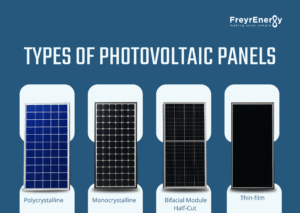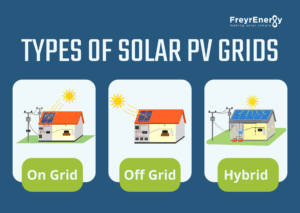Solar energy harnessing has been a mainstay when we talk about sustainable energy resources. The tech advancements within the industry have seen a transformation in how different types of photovoltaic (PV) panels have evolved drastically. With time, these photovoltaic panels are an integral part of any solar setup, and are available across residential complexes, solar parks and commercial places.
Let us dive in deep and understand what a photovoltaic panel is and how effective they have become.
What are Photovoltaic Panels?
Photovoltaic panels are semiconductor panels that absorb direct sunlight and convert it into usable electricity for various use cases. These are usually made using silicon, and some new panels are made using several breakthrough semiconductor materials. The working of a PV panel sees the sunlight falling over the surface of the cell, which is absorbed to activate the electrons, which eventually generate usable electric current.
More so, a solar PV panel combines with other components like mounts, a metal junction box and inverters to produce usable electricity resources.
A solar PV panel is mounted either on an open surface or a rooftop using mounts. There are other crucial components that support a photovoltaic panel to perform efficiently, including:
- Mounts: A mount is a metallic support that holds the panels facing the sunlight. These support structures are manually customized to ensure the orientation and angle of impact are ideal for receiving maximum sunlight.
- Inverters: An inverter is a device that transforms DC transmission as received from the sunlight to usable AC current in houses. These inverters are important to ensure the solar panels work efficiently and offer a stable power output in the process.
- Cables and Electric Boxes: Cables are fitted to ensure all the components are connected. Additionally, these cables play the main role in transmitting power generated via the inverter to meters/ homes.
- Storage Device: A battery-type storage device is a component that’s available especially for off-grid setups. For on-grids, panels are directly connected to the inverters and grid meters. For off-grid, however, storing power for future use cases is imminent, and thus a battery is vital for these setups.
- Tracking Systems: Most of the panel setups are equipped with the installers apps, which help in tracking the system performance, health and all the topics associated with photovoltaic panels.
Materials used in Photovoltaic Panels
- Silicon: Silicon remains the de-facto number 1 choice for solar panels in terms of user volume. A vast majority of the panels installed globally have silicon as the main type of material used. Silicon offers excellent efficiency, tolerance and a longevity that makes it an affordable choice for companies installing regular photovoltaic panels.
- Cadmium Telluride: Cadmium Telluride or CdTe is another form of material used in building photovoltaic panels. The material is used in thin film solar panels and has an efficiency that’s often matched to that of a monocrystalline panel type. More so, the panels have an excellent low-light performance, ideally suited during the monsoons in India.
Types of Photovoltaic Panels

Photovoltaic panels are broadly available in three main types that cater specific use case and energy purposes. Here are the four major types of panels including:
- Monocrystalline: Arguably the most popular type of solar panels used across residential and commercial usages, a monocrystalline panel is made using an unbroken crystal of pure silicon. These panels have excellent efficiency rates of around 20% and longevity of around 25-30 years.
- Polycrystalline: Polycrystalline panels are made using multiple fragments of silicon crystals and are melted together to form a solid piece of crystal. These are then cut into wafers and are second in the line in terms of popularity and use case. These panels boast an efficiency of around 15-17%, which is backed up with a similar longevity of 20-25 years.
- Bifacial: A Bifacial solar panel type is one where the structure of photovoltaic cells absorbs sunlight from both directions. These types of panels have a better absorption rate and are ideally suited for open area solar harnessing opportunities.
- Thin-film variants: Thin-film panels are made using materials like CdTe and appear in a thin and flexible sheet of photovoltaic panels. They are lightweight and easy to install.
Types of Solar PV Grids

There are three types of photovoltaic cell grids that are commonly used for different use case, including:
- On-grid: The most common system where the PV panels are connected to the grid and utilize the power supply alongside.
- Off-grid: Off-grid devices are standalone devices that require a battery to store any power generated.
- Hybrid: These are flexible types that come with a battery storage unit and are connected to the grid as wel
Final Thoughts
Photovoltaic Cells hold the key for the foreseeable future in terms of power generation. With the future of newer advancements in semiconductor materials, it won’t be surprising to see a new breakthrough that adds to enhancing Solar PV technology in the future.
